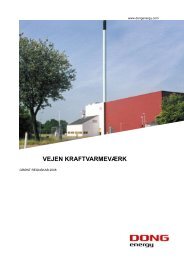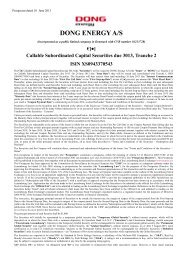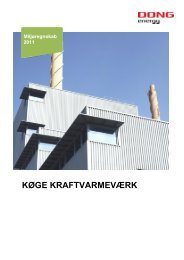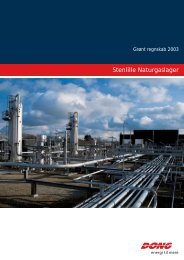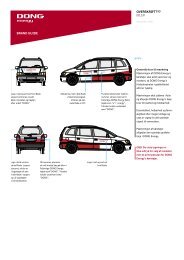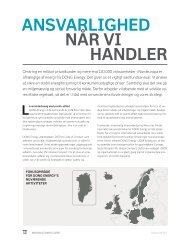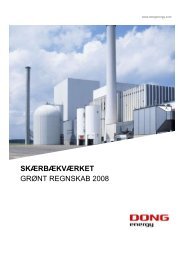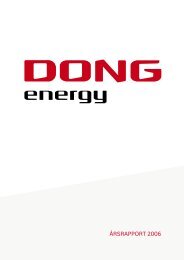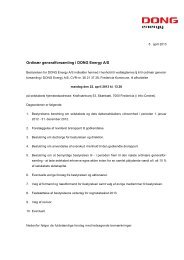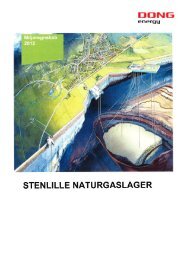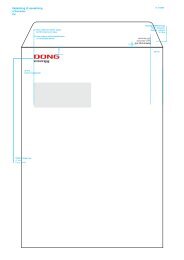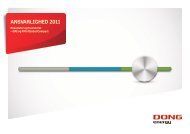ANNUAL REPORT 2011 - DONG Energy
ANNUAL REPORT 2011 - DONG Energy
ANNUAL REPORT 2011 - DONG Energy
Create successful ePaper yourself
Turn your PDF publications into a flip-book with our unique Google optimized e-Paper software.
notes<br />
32 Credit and market risks<br />
DKK million<br />
Clearing<br />
centres AAA/Aaa AA/Aa A/A BBB/Baa Other total<br />
<strong>2011</strong> 3,430 8,350 5,226 8,621 1,471 9,078 36,176<br />
2010 7,153 7,097 4,883 8,212 357 7,897 35,599<br />
Credit risks<br />
The table above provides an overview of the credit quality of<br />
the market value of derivative fi nancial instruments, cash and<br />
bond portfolios and trade receivables at 31 December <strong>2011</strong><br />
in the <strong>DONG</strong> <strong>Energy</strong> Group based on the individual counterparty’s<br />
ratings with Standard & Poor’s and Moody’s.<br />
The amounts stated do not include any collateral and therefore<br />
do not refl ect the actual credit risk.<br />
Like previous years, <strong>DONG</strong> <strong>Energy</strong>’s counterparty risks are<br />
concentrated on companies with a rating of A/A or above. The<br />
AA/Aa and A/A categories cover trading with large international<br />
energy companies and banks. Such trading is regulated<br />
under standard agreements, such as EFET and ISDA agreements,<br />
which feature credit rating and netting provisions. The<br />
AAA/Aaa category covers <strong>DONG</strong> <strong>Energy</strong>’s position in Danish<br />
AAA-rated mortgage bonds.<br />
The value of trading at clearing centres decreased signifi cantly<br />
compared with 2010, whereas the other categories increased.<br />
This refl ected a combination of changed trading activity in<br />
connection with hedging of <strong>DONG</strong> <strong>Energy</strong>’s market risk and<br />
market value changes in relation to the date of conclusion<br />
of each transaction determined at 31 December. The ‘Other’<br />
group predominantly consists of trade receivables from customers,<br />
such as end users and PSO customers.<br />
Further details of the Group’s risk management are provided<br />
in the chapter on Risk and risk management on pages 44-49<br />
of Management’s review.<br />
market risks<br />
The market risk on commodities primarily relates to portfolio<br />
management and trading activities. The Group is exposed<br />
to two types of energy risk: fl uctuations in market prices and<br />
fl uctuations in volumes due to the fl uctuating needs of the<br />
underlying business.<br />
By virtue of its day-to-day activities, the Group is exposed to<br />
fl uctuations in the prices of gas, oil, electricity, coal and CO2 108 112 COnsOliDatED finanCial statEmEnts – <strong>DONG</strong> ENERGY GROUP <strong>ANNUAL</strong> <strong>ANNUAL</strong> <strong>REPORT</strong> <strong>REPORT</strong> <strong>2011</strong><br />
<strong>2011</strong><br />
and, to a lesser extent, other commodities. The Group trades<br />
actively in these commodities in the relevant markets to hedge<br />
and optimise its supply requirements and secure the Group’s<br />
supply chain. In this connection, the Group uses derivatives to<br />
hedge its positions.<br />
The sensitivity analysis below shows the effect of market value<br />
changes assuming a relative price change at 31 December<br />
<strong>2011</strong>. The illustrated effect on profi t comprises fi nancial instruments<br />
that remained open at the balance sheet date and have<br />
an effect on profi t in the fi nancial year in question. Besides<br />
derivative fi nancial instruments on commodities and currency,<br />
fi nancial instruments in this context include receivables and<br />
payables in foreign currencies.<br />
It should be noted that the illustrated sensitivities only comprise<br />
the Group’s fi nancial instruments and therefore exclude<br />
the effect from contracts concluded under which physical<br />
delivery of the underlying assets is made, as these are not<br />
recognised as fi nancial instruments in accordance with IAS<br />
39. The sensitivity thus only comprises the derivative fi nancial<br />
instruments and not the physical contracts they hedge.<br />
The implementation of business performance has made the<br />
Group more sensitive to changes in commodity prices and<br />
exchange rates in the statement of comprehensive income, but<br />
has reduced its sensitivity in equity. The fi nancial instruments<br />
that form part of the sensitivity analysis are fi nancial instruments<br />
and fi nancial contracts measured at market value and<br />
the Group’s receivables, cash and trade payables and its external<br />
fi nancing such as bank loans and bond loans.<br />
Net investments and associated hedging of net investments in<br />
foreign subsidiaries are not included, as the effect of the sum<br />
of the investment and the hedging is considered to be neutral<br />
to price changes. For further details of the Group’s net investments<br />
and hedging of same, reference is made to note 33.



